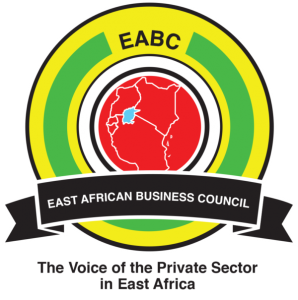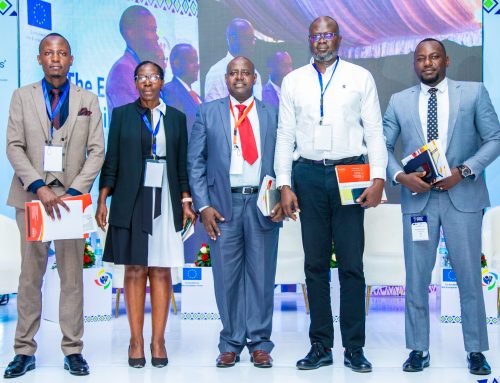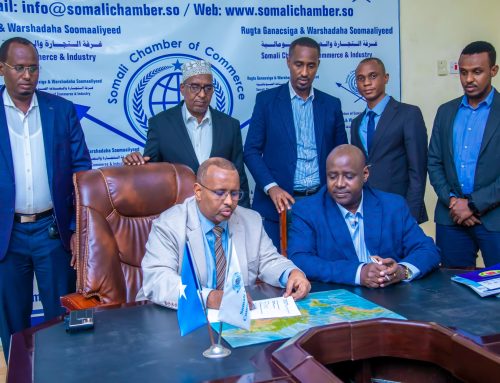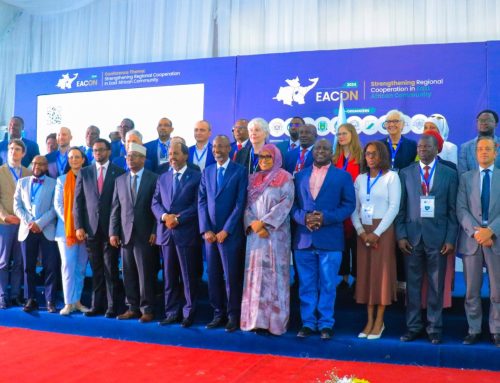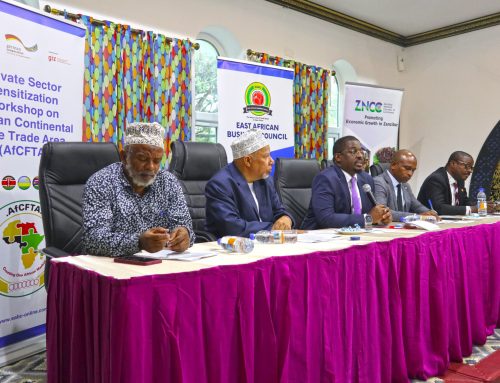Summary of the assignment:
| Nature of assignment | Short term |
| Location | Within EAC |
| Timeframe | 18 Working days |
| Reporting | To Executive Director/CEO |
| Date | 2nd Feb 2022 |
1.0 BACKGROUND TO THE EABC TRADEMARK EAST AFRICA (TMEA) PROJECT
The East African Business Council (EABC) is the umbrella body of the Private Sector in the East African Community (EAC). It brings together national private sector umbrella bodies, manufacturers, employers, bankers, insurance and transporters associations, chambers of commerce, corporates, and medium and small enterprises from the entire East African region.
EABC’s mandate is to represent and promote the interests of the EAC business community, provide value-added services that enhance trade and competitiveness, and participate actively and positively influence legal and regulatory formulation to improve the business environment. EABC works with the major stakeholders such as the EAC Secretariat, Organs, Institutions and National Governments and provides input in policy discussion while advocating for the implementation of resolutions at the national level aimed at increasing intra-regional trade. For effective implementation of the Regional PPD programme, EABC was selected by TMEA as the lead implementing partner for the Private Sector Organizations.
TradeMark East Africa (TMEA) is a multi-donor funded, not-for-profit organisation, established in 2010 to promote regional trade and prosperity in East Africa. TMEA combines a regional approach with national-level interventions and works closely with East Africa institutions (e.g., East African Community EAC Secretariat, Corridors Authorities), national governments, and private sector and civil society organisations. TMEA has its headquarters in Nairobi – Kenya with branches in Burundi, Rwanda, South Sudan, Tanzania, Uganda and The Democratic Republic of Congo (DRC). TMEA has recently revised its strategic focus in line with national, regional and global priorities as defined in its new corporate strategy (2017 – 2023). The revised Theory of Change (TOC) is anchored on two strategic objectives: (i) Reduced Barriers to Trade; and (ii) Improved Business Competitiveness. Under the improved business competitiveness strategic objective is TMEA’s Public-Private Dialogue (PPD) for trade and investment programme.
The East African Business Council (EABC) is implementing the TMEA project titled Public‐Private Sector Dialogue (PPD) for Trade and Investment in Eastern Africa.
This is arigional project targets to mainstream advocacy throughout TMEA’s project clusters which are transport & logistics; customs & tax; standards & Sanitary Phyto Sanitary (SPS) Measures; African Free Trade Area (AfCFTA) & Tripartite Free Trade Area (TFTA) and Non-Tariff Barriers (NTBs). The programme’s core objective is to enhance private sector organisations’ (PSO) capacity to proactively and positively influence decision‐making, to accelerate dispute resolution, to sustain political buy‐in, to increase commitment and to reduce overall programme risks in TMEA’s project clusters. This will increase trade and investment in the EAC. The Regional Programme will contribute to core TMEA corporate results outlined below:
- Reduce transport (road, rail, and air) cost and time along transport corridors by 10% and increase efficiency in private sector logistics services provision
- Enhance Customs and other trade‐related agencies efficiency (25% reduction in time to process trade documentation) through integrated trade management systems and greater inter‐agency collaboration.
- Reduced tariffs, taxes, and levies by 5‐8% overall (including sub‐national) reduce exemption regimes, CET, and increase import/export tax incentives
- Enhanced efficiency of Bureaux of Standards, reduce related costs and time by 10%, reduce counterfeit and sub-standard goods by 20% through enhanced inter‐agency collaboration and improve private sector compliance.
- Resolve 30% of all reported NTBs along TMEA project clusters within a year.
- Catalyzing a 10% increase in exports annually, 93,000 direct jobs and $425m additional investment after seven years in targeted sectors in the EAC under the Compact and TLCs through increased investment incentives.
- RATIONALE AND OBJECTIVE OF THE ASSIGNMENT
One of the EABC-TMEA project outcomes is to improve the adoption and harmonisation of customs and domestic tax-related policies and principles among the Partner States with a view of reducing tariffs, taxes, levies, exemption regimes and increasing import/export tax incentives. In line with this outcome, the EAC Customs Union Protocol (CUP) provides that within the Customs Union, a Common External Tariff (CET) in respect of all goods imported into the Partner States from foreign countries shall be established and maintained. Through Article 12 of the CUP the Partner States established a three-band common external tariff with a minimum rate of 0 per centum, a middle rate of 10 per centum and a maximum rate of 25 per centum in respect of all products imported into the Community. The implementation of the EAC-Common External Tariff (CET) commenced in January 2005 after coming into force of the EAC Customs Union Protocol.
The EAC CUP provides the review of the EAC CET every five (5) years. The EAC CET was last reviewed in 2010 whereby the three-band rate was maintained. However, each year, EAC Partner States through EAC Pre-Budget Consultations of the Ministers of Finance have been doing annual reviews on specific products. These annual reviews have been manifested with an increase or decrease of duty rates for specific products depending on product availability in the region. The annual reviews have been clouded with the EAC Partner States requesting Stay of Applications (SOAs) of EAC CET and unilaterally applying different rates, and numerous applications of country-specific duty remissions. This has resulted in the non-uniform application of EAC CET by the EAC Partner States and fluctuations of CET. This has going against the EAC CU which defines CET as an identical rate of tariff imposed on goods imported from foreign countries into EAC.
In addressing various challenges associated with existing EAC CET, in 2016 the EAC Partner States agreed to comprehensively review the CET in order to align the existing tariff structure and rates with dynamic global trade changes and trade environment; eliminate the use of stays of application by EAC Partner States, minimise the list of products falling under the duty remission scheme, address the degree of processing and match applicable rates with supply capacity within the region to avoid trade distortions.
By end of 2021, the EAC Partner States registered various milestones with regards to the review of EAC CET. Some of these milestones are: agreement on to move from 3-band tariff structure to 4-band of 0% for raw materials and capital goods, 10% for intermediate goods, 25% for finished products which are not sufficiently available in the region and a rate above 25% which is either 30% or 35% for final products which are sufficiently available in the region; criteria for classifying and categorising of goods in four categories and moving 459 tariff lines to the maximum CET rate of either 30% or 35%. Despite these achievements, EAC Partner States have taken too long to finalize the process due to the divergent positions on the maximum CET rate of either 30% or 35%. While some Partner States are pushing for 30% others are supporting 35% as the maximum CET rate. While the governments of the EAC Partner States have divergent positions on maximum CET rate the EAC Private Sector is also lacking consensus on which maximum CET rate should be adopted.
In view of the above, EABC Secretariat through TMEA Regional PPD Programme is commissioning a consultancy to undertake a study on the maximum CET rate. This study will analyse the proposed maximum CET rates of either 30% or 35%, their impact on EAC economies and suggest the right rate to be applied supported by concrete arguments. The study should also come up with clear recommendations & an advocacy roadmap to build consensus on the proposed maximum CET rate.
The consultant should undertake the following:
4.0 deliverables
The key deliverables include:
- which among other things will contain the detailed work plan for carrying out the scope of work, proposed methodology and research design survey instruments;
- of analysis of the proposed maximum rates of 30% and 35%
- that includes, analysis of Maximum CET rates of 30% and 35%, the impact of the rates to EAC/Regional economies, arguments for supporting the rates and clear recommendations on which rate to be adopted;
- containing asummary of the findings on Maximum EAC CET Rates, Impact of the proposed CET rates of 30% and 35%, their impacts on EAC/regional economy as well as clear recommendations on rate to be adopted;
- on Private Sector Positions on recommended Maximum CET Rate which will guide Regional Private Sector consultative meeting on Maximum CET rate.
5.0 QUALIFICATIONS AND EXPERIENCE
A suitable candidate should hold the following qualifications and key competencies:
- Academic qualifications: A Master’s degree or postgraduate qualification in any of the following fields, Economics, Taxation/Customs, Business Administration or any other relevant field is required.
- A minimum of four (4) years’ years’ demonstrable experience in conducting research /surveys on tax/trade-related fields, an understanding of business & taxes across EAC region.
- Work Experience: Demonstrate experience in undertaking at least four consultancy of similar work at regional/national level;
- Communication and Networking: Must be able to identify key stakeholders; seek their views, correctly interpret their messages and respond appropriately
- Knowledge of EAC Integration: Must demonstrate strong knowledge of EAC integration, international trade, policy design and technical framework on Regional Trade Arrangements and be very conversant with social, economic and geo-politics of EAC.
- Languages: Fluency in oral and written English is required as it is the main EAC working language. Good working knowledge of French and Kiswahili will be an advantage.
- Additional Skills: Excellent computer skills (Microsoft Office, Word, PowerPoint, and Excel, Email, analytical tools/software for data analysis, experience in working with internet searches, online databases, and data retrieval) are required.
- Nationality: The position is only open to Nationals of any of the EAC Partner States: Burundi, Kenya, Rwanda, Tanzania, Uganda and South Sudan.
- TECHNICAL & FINANCIAL EVALUATION CRITERIA:
| Technical Evaluation: | Maximum |
| A minimum of four (4) years’ years’ demonstrable experience in conducting research /surveys on tax/trade-related field, an understanding of business & taxes across EAC region. | 15 |
| Knowledge of EAC Integration: Must demonstrate strong knowledge of EAC integration, international trade, policy design and technical framework on Regional Trade Arrangements and conversant with social, economic and geo-politics of EAC. | 10 |
| Experience in delivering at least four similar assignments at the regional level (preferably EAC) | 10 |
| Approach and Methodology : Proposed methodolpgy and approach focusing on how the assignment will be conducted (10) Stakholder mapping, management plan and stakeholder engagement plan (05) Workplan and sequencing of activities (10) Anticipated issues, challenges and mitigation in undertaking the assignment (05) | 30 |
| Academic qualifications: A Master’s degree or postgraduate qualification in any of the following fields, Economics, Taxation/Customs, Business Administration or any other relevant field is required. | 05 |
| Total technical score | 70 |
| Financial Evaluation (Financial Quotations) | Maximum |
| Fees | 20 |
| Reimbursable | 10 |
| Total Financial Score | 30 |
| Overall Score | 100 |
.
- THE APPLICATION PROCESS
The technical and financial proposal must be submitted separately addressed to;
The Executive Director / CEO
East African Business Council (EABC)
Ninth Floor, Mafao House, Old Moshi Road P. O. Box 2617 Arusha, Tanzania.
Email: director@eabc-online.com with a copy to procurement@eabc-online.com
Clearly marked “Consultancy to Undertake Study on Maximum CET Rate to Consensus in the EAC”.
The technical proposal should also contain a current curriculum vitae, work plan and methodology.
The financial proposal should be protected with a password.
Applications close on 23rd February at 05.00 p.m.
EABC is an equal opportunity employer thus recruitment is on merit and with no regard to one’s age, colour, gender, marital status, disability or impairment, race or creed.
Canvassing shall lead to automatic disqualification.
Environmental aspects will be taken into consideration.
END
